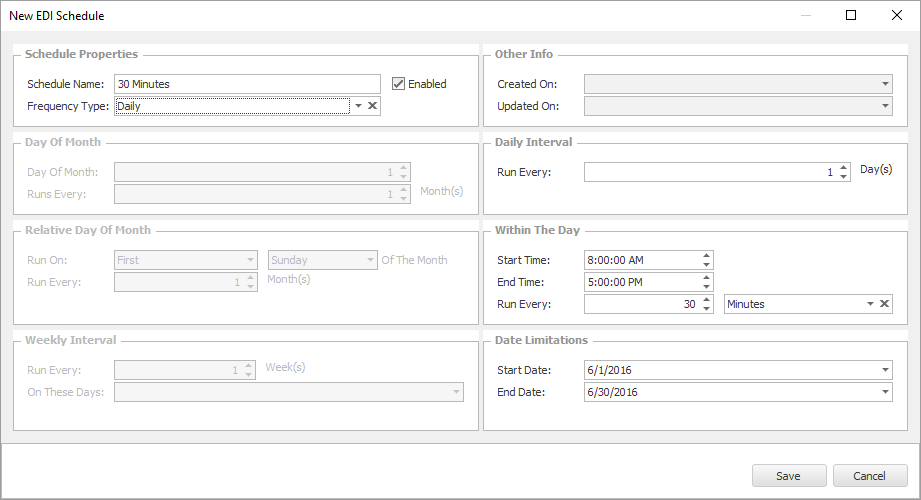Overview
The EDI Scheduler is used to create a schedule for the system to retrieve new incoming EDI documents from the server. These EDI Documents will be downloaded and automatically processed based on previously created mappings. It is recommended that your SalesPad application be set up and running on the server hosting your SQL environment so that this processing can happen as quickly as possible. This is especially important if you receive a high volume of EDI documents that need to be processed.
In this document, you will learn how to create and edit schedules and how to run an EDI task using schedules.
Table of Contents
- Overview
- Schedules
- New EDI Schedule
- Usage
Schedules

The EDI Schedules screen shows all of the currently created schedules, basic creation information, and an enable checkbox which shows or hides the schedule in the Server Connections window when you assign a schedule to server connection.
Along the top of the EDI Scheduler screen are buttons that allow you to create, delete, edit, or copy schedules. The Preview button generates a list of times when the schedule would run if it was started right now.
New EDI Schedule
When you click New you’ll be presented with this screen.

Here you can fine tune a schedule for when your system will attempt to download and process new EDI documents. Your schedule can be set up to run daily, weekly, a particular day of the month, a relative day of the month (such as the first Wednesday), or just one time. The example above will run every day in the month of June 2016 between the hours of 8:00 AM and 5:00 PM and will check the server every 30 minutes.
Usage
Once you’ve created a schedule, follow these steps to activate it:
- Open Server Connections.
- In the EDI Schedule column, choose your Schedule from the dropdown. Only one schedule can be assigned per server connection.
- Click Save.
- Open the EDI Processing screen.
- Click Start.
The EDI processing screen will now attempt to download and process a file at set times based on your schedule. Click Stop to halt this process. You can keep track of the task’s status (started, sleeping, cancelled, etc) in the bottom window. While the task is running, you’ll no longer be able to close the EDI Processing screen until the Stop button has been pressed. This is to prevent users from accidentally stopping the scheduler.
Note: If there are no schedules assigned to a server and you press the Start button, it will attempt to download EDI documents evert 10 minutes by default. If you wish to change this, go into Settings, search for “EDI Processing Download Frequency”, and change the value.
SalesPad Support
Comments